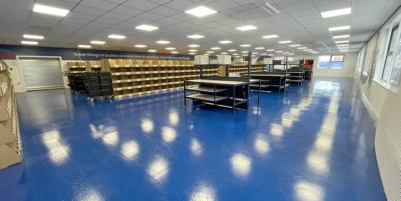-
BLACKOUT TECHNOLOGIES TARGETS TELEMATICS-INTEGRATED MOBILE DEVICE BLOCKING TO COMBAT SMARTPHONE DISTRACTION - April 1, 2025
-
OpenADR Alliance announces first OpenADR 3.0 certified products with EVoke Systems, E.ON Energy and Universal Devices - March 25, 2025
-
Growing fulfilment and contract packer appoints new Managing Director - March 25, 2025
-
When is it time to invest in a WMS? Understanding the key trigger points - March 25, 2025
-
eCapital helps Vantage Recruitment on its journey to financial success - March 24, 2025
-
Hugo Beck Celebrates 70 Years of Packaging Innovation with Open House Events - March 20, 2025
-
PROLOG FULFILMENT SUPPORTS LUNA DAILY’S COMMITMENT TO BETTER BODY CARE FOR ALL WOMEN - March 19, 2025
-
Motion Ventures launches largest-ever maritime tech fund at $100M to meet the industry’s new pace of adoption - March 18, 2025
-
ITD GLOBAL APPOINTS GROUP CHIEF REVENUE OFFICER - March 17, 2025
-
SURECAM TEAMS UP WITH ENTERPRISE FLEX-E-RENT FOR VEHICLE REPAIR & MAINTENANCE CONFERENCE - March 14, 2025
Demand for packaging materials in many sectors has reached an all-time high in recent months, fuelled by the explosion in e-commerce due to Covid-19. According to international packaging industry analysts Smithers, the global market for packaging materials is expected to continue expanding by a steady 3% annually, to become a $1.2 trillion sector in the next 8 years. These figures were compiled before the Coronavirus pandemic and since the outbreak hit, there has been a steep increase for some types of packaging and a decline in demand for others. McKinsey has also observed a sharp rise in packaging materials demand, especially for the varieties needed for groceries, healthcare products and e-commerce transportation. At the same time, demand for industrial, luxury and some B2B-transport packaging has declined.
All these developments mean that what was previously quite a conventional, stable industry is being very rapidly shaken up. Companies in the sector are seeing a need to improve efficiencies and scale quickly, which in turn, is generating an increased appetite for warehouse automation. In this respect, packaging firms have two options – be reactive to their customer’s changing processes and lead times; or they can be proactive and agile, bending and twisting to meet demands whilst also anticipating their next moves.
Traditionally many packaging companies have succeeded by locating multiple sites in close proximity to customers, allowing them to respond quickly to incoming stock orders. They would likely have had contracts in place for set volume deliveries and were required to hold up to 6 weeks worth of pre-scheduled inventory at any time. By operating multiple warehouse sites near to customers, packaging firms could supply their customer networks rapidly and effectively meet a pre-agreed timetable of deliveries.
Although this model has worked well for many packaging companies for a long time, it can result in high levels of resource wastage. In the “new normal” pandemic world where budgets are tighter, a more efficient alternative is ‘hub and spoke’ distribution. Here, rather than having many sites located in a small area, it makes far more sense to hold the majority of stock in a distribution centre and continually cross dock that inventory into a larger number of much smaller, less costly to run mini fulfilment points. The smaller ‘spoke’ centres then make more frequent, automated stock replenishments to the end customer, which avoids the expense of having to hold large amounts of stock in every location.
Further complicating the current situation, increased demand for goods means previous stock forecasts may not be accurate. Rather than staying with the pre-agreed timetable of deliveries, packaging manufacturers and distributors are seeing more peaks and troughs. Today’s packaging business shares many characteristics with the stationery sector, where specialists are expected to hold a huge range of items in stock and respond to customer orders with next day delivery services.
Now, while the packaging industry is benefiting from e-commerce growth, an opportunity exists to re-configure historical distribution networks and automate, introducing warehouse technology to improve efficiency. An obvious place to start is with warehouse management system (WMS) software. This allows packaging companies, who need to become more agile businesses, to more closely examine fixed costs and find ways to improve efficiency. In doing so, they can benefit from all aspects of the improved control and management functions that this type of warehouse automation brings. This includes better management of resources and operatives as well as inventory and stock movements. Here are six ways warehouse technology will improve operations for packaging companies.
Careful inventory management
Many packaging companies offer bespoke packaging products and this type of inventory can represent as much as 70% of their total business volumes. Specialising for customers is good for business, but creates the problem of having to very carefully manage stocks to minimise exposure to risks and wastage. The accurate real-time inventory reports that a WMS can deliver allows companies to rationalise their holdings where possible and therefore remove risks and unnecessary cost from the supply chain.
More dynamic business environment
Contracts negotiated between packaging companies and their customers are changing as a result of Covid. Rather than having long lead time orders and routine product deliveries called up over a set period of time,
sales patterns are much more dynamic now. There is a lot more uncertainty to manage through and a WMS can help companies to respond quickly and with agility in this dynamic environment.
Improved stock control
Although packaging materials might not be perishable in the usual sense, rotational date control is still very important. Stocks can still ‘go off’. Bubble wrap in particular has a short shelf life, because the air inside the bubbles starts to leach out as soon as it is produced. It therefore needs to be used up quickly, especially where stocks are branded and not re-sellable elsewhere. A WMS will help ensure cost efficient stock rotation in the warehouse and minimise stock loss caused by expiration or obsolescence.
Dynamic location management
Packaging companies often hold an unusually high number of ‘ugly’ stock items – products that are unusual sizes or shapes and more difficult to accommodate in the warehouse. Using a WMS allows stock locations to be assigned dynamically wherever there is an available location, rather than having pre-set spaces allocated. It is a much more efficient way of managing stocks in the warehouse.
Improved resource management
When customers experience seasonal peaks, this translates into extra busy periods for packaging suppliers also – for example on Singles Day, Black Friday and Cyber Monday. Packaging companies will often need to recruit temporary workers to get through these busy phases and getting new operatives fully efficient in the shortest possible time can eat into margins. When processes are driven by WMS technology, the learning curve is almost eliminated.
Sustainability and packaging
Finally and possibly the most pressing issue for packaging companies to overcome is minimising waste. Having to repulp or dispose of materials that are no longer required or useable needs to be avoided as a priority. Apart from the cost implications, even where the items can be recycled, it is still an environmental resource management issue. Given that around 70% of stock items held are bespoke to a brand and not useable anywhere else, the improved stock management benefits of using a WMS also help to avoid this unnecessary wastage. Decarbonisation and minimising the environmental footprint of a business’ operations is an Increasingly important strategic priority and something no packaging company can neglect.
Ultimately, it might only come in one or two colours – brown and transparent being the most obvious – but packaging is very much like the fashion industry. It’s a booming business and changing all the time, so attention to detail and finding ways to do the little things really well, especially taking advantage of increased automation in the warehouse, can make a huge difference.
Author
Eric Carter, Solutions Architect
Indigo Software

































